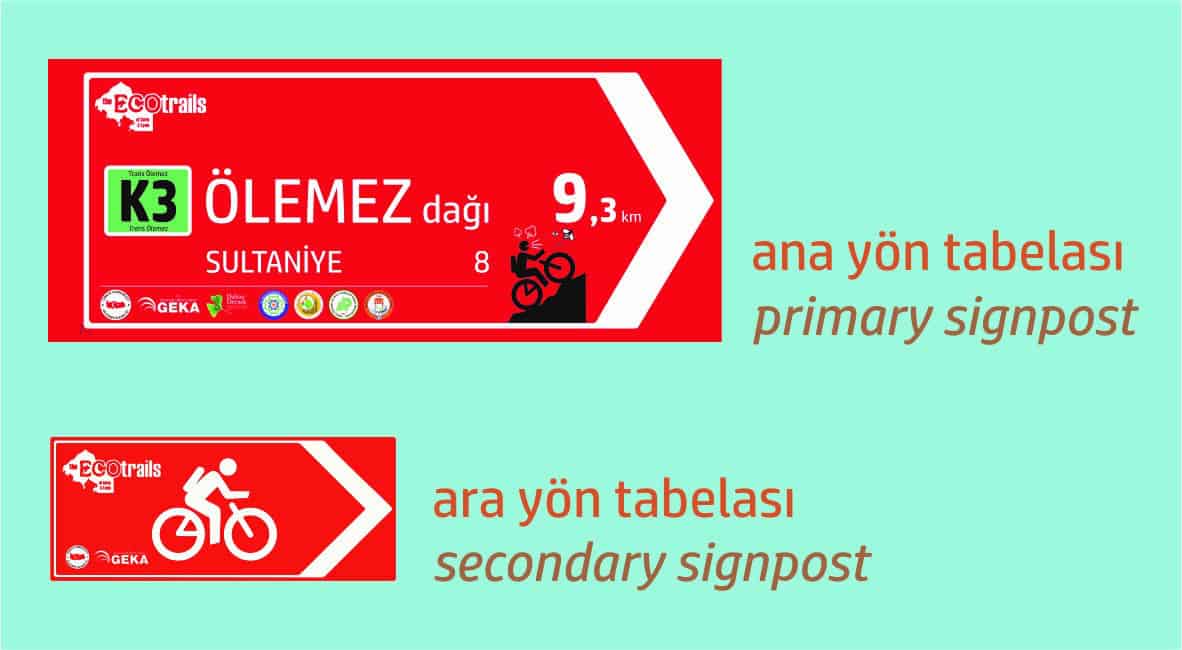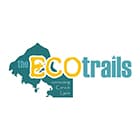The ECO Trails consist of 470 km hiking and 700 km cycling routes. All of the routes have direction signs and boards prepared according to the international standards, aligned with the current applications. Besides these, GPS records of the routes and mobile application are created and can be used.
A significant portion of the routes is in Köyceğiz-Dalyan and Fethiye-Göcek Special Environment Protection Areas. Döğüşbelen-Dalyan section of the hiking trails and “Köyceğiz Lake”, “Sweetgum Trail” and “Trans Ölemez” cycling routes pass through Köyceğiz Wild Life Development Zone while avoiding the Absolute Protection Zones within.
An Information board which includes a route map, route information and the distances on the trails are located at Köyceğiz, Ortaca, Dalaman and Dalyan city centres, Karabörtlen junction and Günlüklü junction on D400 Muğla highway, near Tuzla pass at the start of Çameli cycling routes and Hamitköy Namnam bridge. Additionally, joint information boards are placed at the viewing platforms of Cape Yoğun and Sinan Kavağı in Köyceğiz Wild Life Development Zone.

Waymarking
Waymarking is at international standards and provides coherence with national practices.
Hiking trail waymarking includes yellow signposts at important crossroads providing destination names with distances, plate number, route name and code and partner logos. Between the signposts, the trails are waymarked with red and white lines painted on rocks or other suitable places just as done on the Lycian Way and Carian Trail.
IMPORTANT NOTE: There may be parts of trails where waymarking or repair works continue. Before you hike, visit the “Hiking Trails” page on The ECO Trails website to see these routes, which are classified as “closed routes” until the work is completed.

On cycling routes, red signposts are used to show the direction at the main crossroads; the plate provides destination names with distances, plate number, route name and code and partner logos. Smaller red signs are introduced at the secondary crossroads to prevent sign pollution. There are no painted markings on the cycling route.
IMPORTANT NOTE: Location Plates with QR codes are planned for each signpost, but they are not installed yet.
Hike and bike in any season
The mild climate at the ECO Trails geography allows you to do activities year long. Spring and autumn are the best times for hiking and cycling; you can escape from the heat in the summer by using the routes in the north. If you don’t like snow and cold, you should avoid some of the northern routes which are covered with snow and use middle and coastal routes. The highest altitude is 1450 m for hikers and 2000 m for cyclists; usually, there’s snow from 1000 m altitudes in winter.
What to wear
The clothes for hiking and cycling should be light but healthy, should not hinder movement, and comfortable; shorts and t-shirts in late spring through summer, trousers and long sleeves in spring and autumn, and wool or polar clothes in winter are suitable. Instead of wearing very warm clothes, it is preferable to wear layers of light, breathable clothes (This kind of clothes absorbs and throws out sweat rapidly and dries easily; with this, you can keep your body temperature stable by taking clothes off when you are hot and putting on more layers when cold. Neither sweating more than usual nor feeling cold is good in nature).
Good shoes, good backpack!
If you don’t choose a suitable hiking boot or cycling shoes, you may turn your day into a nightmare, so it should be the most important equipment to pay attention to.
You should carry a backpack even if it is a small one while using the routes. You better keep your hands empty in case of an accident to keep your balance steady.
You can have an idea about what to take with you on a daily hiking or cycling tour by looking at the following list. Please keep in mind that this list can include everything you need and you may want to add more according to your personal experience and needs.
10+ basic materials:
– Spare clothes
– Water (minimum 1 lt of water in a bottle or some kind of water container, good for a daily tour; take more depending on the route distance, route classification, personal consumption, in summer)
– Food (can be arranged according to the length of the tour)
– First aid kit (special medication for allergies, bee stings, etc.)
– A small knife and sewing kit
– Lighter and matches in a waterproof container
– Map of the area, compass and a whistle, GPS if possible
– A torch (head torch preferably)- spare batteries and bulbs
– Sunglasses and sunscreen
– Practical bicycle pump, wheel fix kit, spare inner tube, Allen key
– Bicycle helmet and gloves
– A small notebook and a pen
What do we expect from you?
- Primary responsibility lies with you while using the routes.
- If you are not familiar with the area, get a guided tour, or take with you The ECO Trails guide book & map, a compass, GPS with route data or the mobile application downloadable free from our website.
- Before you start, plan your trip, get the latest route information from the ECO Trails website. Do not hike/bike out of the waymarked routes unless necessary.
- Inform your guide or someone with you if you need to be out of the trails for any reason.
- Take extra care as you pass near holes, hollow sections, steep and narrow passes. Note that reddish/yellowish “kızlan” type of rocks may collapse easily.
- Hike and bike responsibly; avoid any act or behaviour that can harm nature;
- do not leave your rubbish on the trails or in nature; take it with you to the nearest village or town.
- no fires unless necessary
- do not disturb wildlife; do not touch or eat plants you don’t know.
- You probably come across beehives and shepherd dogs in rural areas. In such cases, act calmly and slowly bypass “their” area.
- Do not smoke or drink alcohol or similar drinks while hiking or biking.
- Try and enjoy local flavours, prefer local small establishments to support sustainable tourism.
Please follow these rules in the Köyceğiz Wild Life Development Zone some of the trails pass through:
- It is prohibited to light fires, dispose rubbish, trash, construction debris and any other kind of liquid or solid waste and to do excavations or landfill of any kind except those with the approved scientific requirement.
- In Absolute Protection Zones, animal farming, plants/herbs harvesting, forestry activities, bee harvesting, hunting, road/trail making, buildings including infrastructure, mining, soil extraction, water extraction and irrigation, river diversion, fish farming and any other activity that could damage natural habitats and ecosystem are not allowed.
- Land hunting could only be performed for a limited number of certain animals designated in the Hunting Plan prepared as per Wild Life Management & Development Plan and endorsed by the General Directorate. Fish farming must be done according to the Wetlands Management Plan.
Advertisement, movie/documentary making or other similar profit-seeking activity that includes WLDZ or its resources are subject to permission from the General Directorate.
